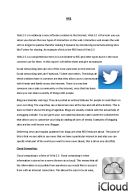In addition to the main memory, there is also the auxiliary storage. This is where programs are stored outside of the CPU. Information can be saved and loaded from secondary storage devices such as CD-ROM and disk. The contents held within these storage devices are stored permanently. With this being said, the processor also has the job of controlling the transmission of information from main memory to auxiliary storage.
Some computer system can involve feedback. Output peripherals feed back into the system to control future outputs. This means that information which has been processed before and output can be used to determine the future outputs of that system. For example many sensors are used for feedback, especially in a supermarket, where a freezer could detect an increase in temperature and therefore feed back in order to tell the system to decrease the temperature.
Types of Computer
There are seven main types of computer:
Supercomputers
These are the fastest and most expensive modern computer systems. They are usually not used in normal data processing, but for performing millions of intense mathematical calculations at the same time. For this reason, supercomputers have multiple processors. They are usually half the size of a classroom and cost around £5-7 million pounds. An example of how a supercomputer might be used is to forecast the weather and also it is used in NASA.
This picture shows the Cray T932 series. It is capable of 56 billion calculations per second, which is matched by its price of £10,000,000.
Mainframes
These are very large computer systems, which usually have multiple processors or one very powerful single processor. There is typically a vast amount of memory, with many communication lines as well. Mainframes are often used as servers on the internet. They are also used in large businesses, such as Barclays, in order to host the very large database needed by the company.
Minicomputers
Minicomputers are types of computers that lie between the desktop computer and mainframes. They can vary in power from a very large and powerful microcomputer to a small mainframe. They often have dual processors and therefore have more capacity to do more work per second. They can be used as network servers and are typically found to be the system, which are aircraft auto pilots or other systems, which must be safety critical. This means that minicomputers are, and most definitely must be, very reliable.
Microcomputers (Desktop Computer)
These are small computers which use one or few microprocessors as its CPU. Microcomputers are usually the desktop models, which range from a few hundred pounds to around ten thousand pounds. A keyboard accompanies a desktop, along with a printer, one or two hard disk drives and sometimes are connected to networks, for example in school. Desktop computers are most commonly found at home and school.
Lap Top Computers
Portable power meant that it was possible for a portable computer to be introduced, the lap top computer. Some of these laptop portables now have the same ability as some of the larger microcomputers. It is usual to have a laptop with 32 or 64 megabytes of main memory, a hard disk with a capacity of around 4 gigabytes and a coloured monitor. A laptop portable can also have communication abilities making it possible for any person to get important data back to the office via a network. The small size and weight of the laptop means that people can do work on a computer anywhere they want.
Personal Digital Assistant (PDA)
These are even more portable than the laptop due to their ultra light weight and ultra small size. They have limited functions but allow people to make small notes or make reminders. Games can even be played on these small machines. They are usually used by people who want something which can go around with them wherever they go. It is typical of a working person to have one of these.
Embedded Computers
Embedded computers are computer systems that are within a device and have a single dedicated job. The functions of these devices cannot be altered by the user as they are programmed by the manufacturer permanently in to the microprocessor. Embedded systems are found everywhere. For example a system controlling the temperature in a greenhouse, the working of a washing machine, dish washer, microwave and many more devices such as the digital watch.
Hardware Devices







